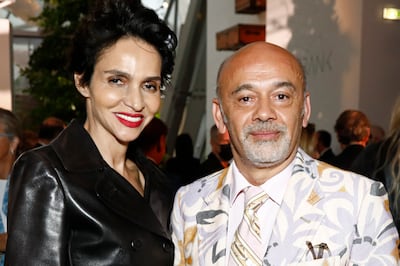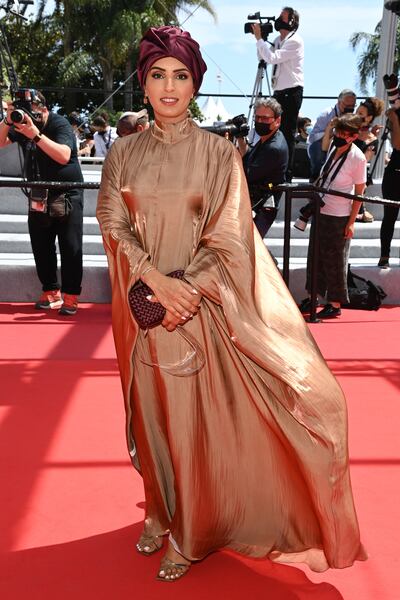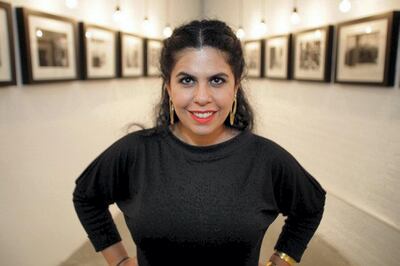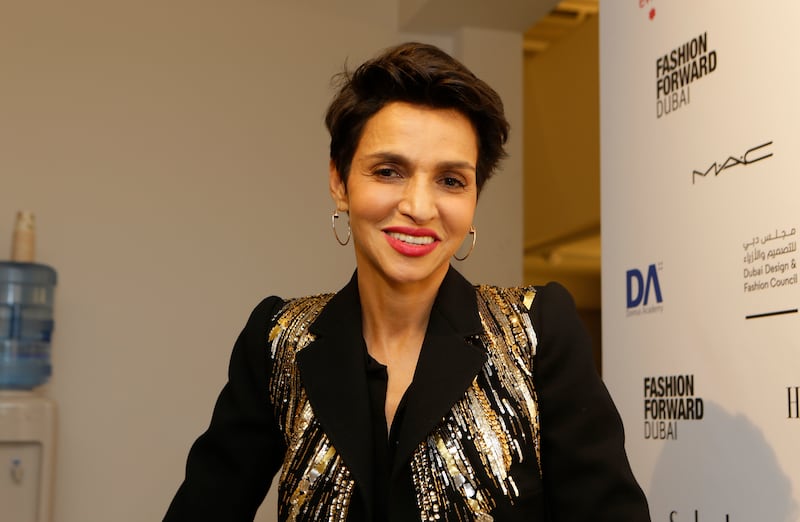Tall and chic in that quintessentially Parisian way, Farida Khelfa is a model, muse, actress and documentary filmmaker.
She was a darling of the Parisian nightlife scene in the 1980s, forging lifelong friendships on the dance floor with designers Jean-Paul Gaultier, Christian Louboutin, Azzedine Alaia and photographer Jean-Paul Goude. Khelfa was eventually lured on to the catwalk, and was one of the first prominent Arab supermodels – decades before diversity became part of the fashion agenda.
She still occasionally models for her designer friends, most recently for Fendi’s spring couture collection, but at 61, her interests now lie behind the camera rather than in front of it.

Over the past decade, she has made documentaries about her famous friends, starting with Gaultier and later Louboutin. In 2012, she filmed Nicolas Sarkozy on his French presidential campaign trail with Francois Hollande, and released a documentary filmed in the aftermath of the Arab uprisings in Tunisia in 2011, shortly after the fall of president Zine El Abidine Ben Ali.
Her latest project is a thought-provoking film called De L’Autre Cote du Voile (From the Other Side of the Veil), which was released in July on Khelfa’s YouTube channel.
Born in Lyon to Algerian parents, Khelfa ran away from her strict upbringing as a teenager, attracted by the bright lights of Paris. This background gives her some insight and understanding of Arab culture, and in her latest documentary, she uses this to offer a refreshing perspective on women living and working in the Middle East. Her aim is to dismantle the prejudices and misconceptions surrounding Muslim Arab women in the region.

“It’s a very personal project,” tells The National. “I wanted to let these women talk and to listen to them, because a lot of people speak for them, and you rarely hear them talk. For me it was fascinating to see their work and see what’s changing.”
The film features a series of interviews shot in Dubai, Saudi Arabia, Qatar and London, with women from across various creative sectors, including fashion designers and stylists, writers, artists, a chef, a film producer and the director of an NGO who runs infrastructure projects in low-income countries.
“I originally thought I would be making a fashion film,” Khelfa says. She was inspired by a trip organised by Vogue Italia and luxury retailer Rubaiyat in 2016 to a Saudi Arabia talents competition in Jeddah, where she co-judged with Silvia Venturini Fendi and Alberta Ferretti. “I discovered all these young women and was surprised by the quality of their work and how well they knew fashion.”
While in Jeddah, Khelfa was invited to Dubai's Fashion Forward, which sparked the idea of making a film on fashion in the region. However, in Dubai, she met not only designers but their friends, who were artists, chefs and writers, and realised there was scope to expand the brief and give all these women a platform. Her mission was to redress the dated and inaccurate way western media portrays women from the region.
Fashion was the starting point. The documentary explores the rich history of traditional garments, such as the abaya, through interviews with designers such as Dubai’s Faiza Bouguessa, Wadha Al Hajri in Qatar and Reem Al Kanhal in Saudi Arabia.

Mariam bin Mahfouz, designer at Sotra and Haal Inc, who won a special award at the Saudi talents competition, suggests that abayas do not necessarily hide the wearer. “It is another play-off from fashion,” she says. “It caters to modesty but isn’t necessarily something that’s not fun or stylish. It became a genre for fashion for us [designers]. It is very empowering … it is like wearing a superhero cape.”
Khelfa went on to visit galleries and museums, and met creatives such as Saudi artist Manal Al Dowayan, who lives in London, and Ghada Al Rabea, who was the only one of her subjects who chose to appear in a niqab and abaya. Khelfa offered everyone the choice of how they dress during filming and recognised Al Rabea was making a statement by wearing hers.

Wearing a niqab as an artist is a challenge, Al Rabea admits, because she is constantly asked how she can be an artist and veiled at the same time. “I knew I had to disassociate my appearance from my painting, so the audience is not influenced by my beautiful or disturbing appearance, and see only my painting,” she says.
She remembers being asked by a Dutchman at one of her exhibitions about wearing the veil and she responded by asking him how he thought people perceived him? “I don’t allow myself to judge you, so why do you judge me?” she says. Her message is to not judge on appearance, but for people to see beyond her abaya and consider what she thinks, desires and dreams of.
Khelfa describes Al Rabea as a charismatic hard worker who creates paintings that are full of joy and light. “It was not the idea I had before of the Saudi woman, and so it was interesting for me to deconstruct the misconceptions in the West about Muslim women.”

Khelfa removes herself from the conversation and gives her subjects the space to speak their truth. In another powerful interview, Fatma Al Remaihi, chief executive of the Doha Film Institute – a company that supports budding Arab filmmakers – highlights how 20 per cent of independent films in the Middle East are made by women, compared to only 9 per cent in the US. These women are not necessarily feminists or typical of their culture, but are strong and confident and striving for independence.
As Al Dowayan points out, Saudi women are depicted in one of two ways: the activist who ends up in jail or the veiled and oppressed victim. The women in the middle, working towards change within the system, are ignored.

It is rare to see a documentary with footage like this. Khelfa let the filming develop organically, with subjects introducing her to others. “It is always the best way,” she says. “I had the same experience when I was filming in Tunisia after the revolution. If you plan too much in advance for a documentary it isn’t good. You have to live in the moment.”
She believes the openness of her subjects was encouraged by her personal experience as a filmmaker of Algerian heritage. “I don’t come from the same background, but I come from a Muslim culture and that is probably why they felt comfortable with me.”
De L’Autre Cote du Voile is being released at a time of tension in Khelfa’s home country, following the French government’s attempt to ban girls under the age of 18 from wearing the hijab in public. The bill, debated by parliament in April, drew condemnation from around the world and led to the viral #HandsOffMyHijab protests and fears of Islamophobia deepening in France.
Khelfa wants her documentary to be constructive. “I was very touched by these women; moved by the way they wanted to achieve things. It’s worth listening to them and seeing past the veil and all the stereotypical opinions that obstruct our view of these women. I hope the documentary will open more eyes.”






